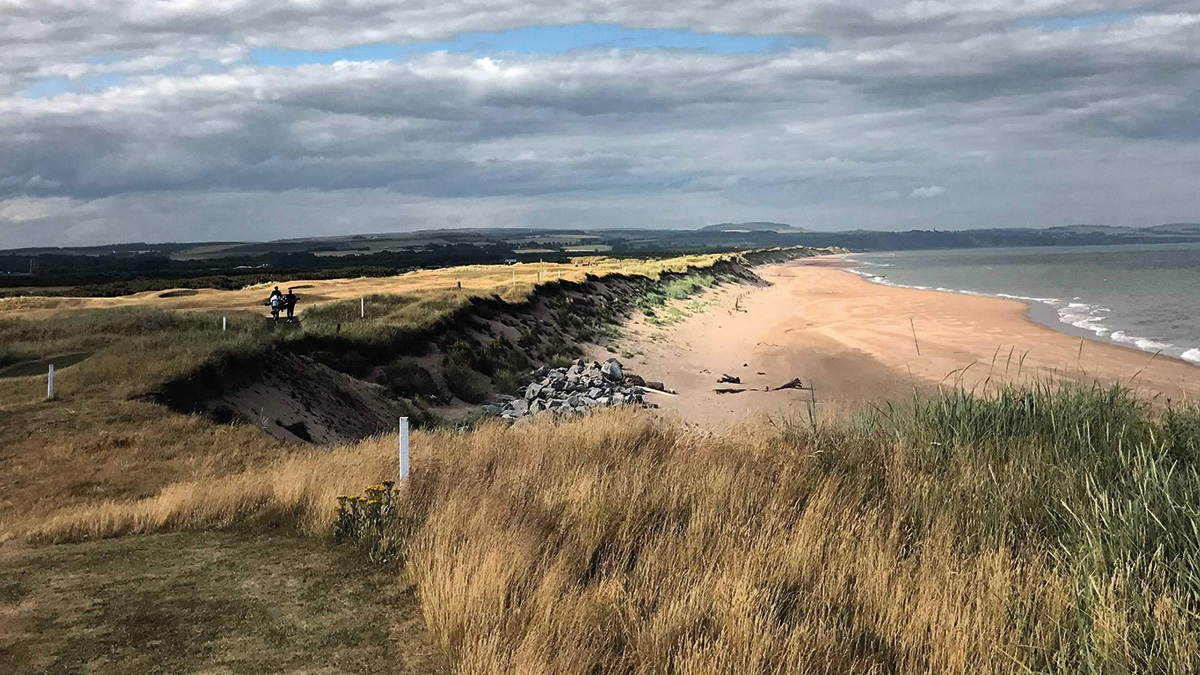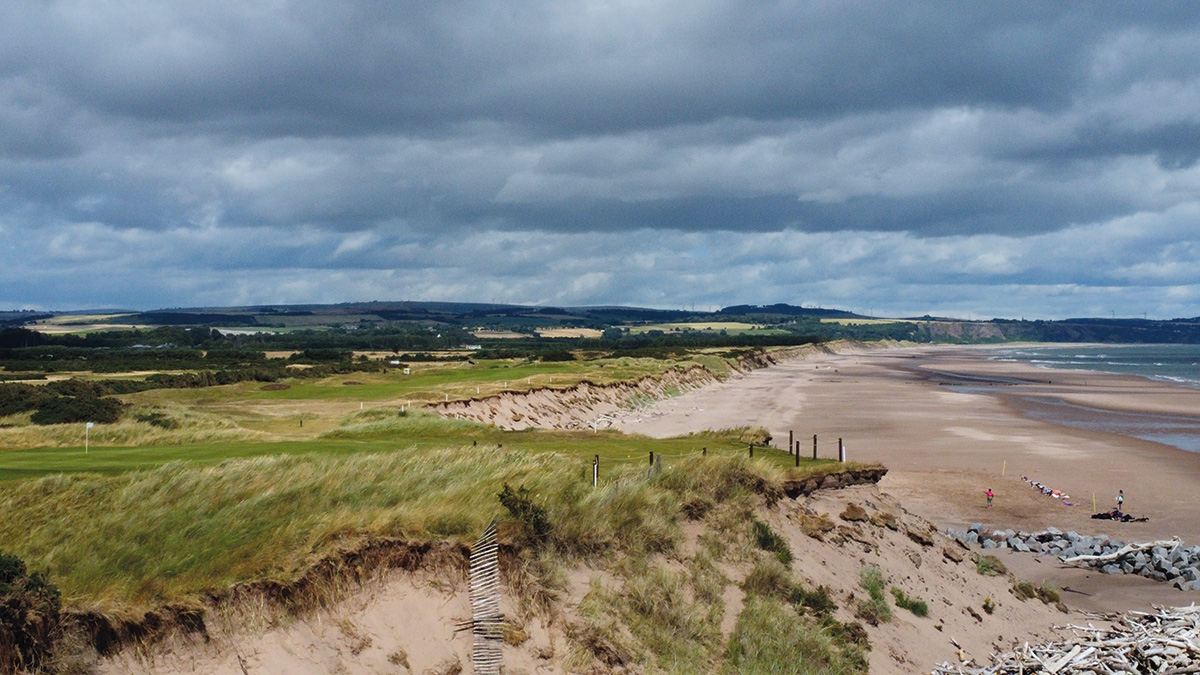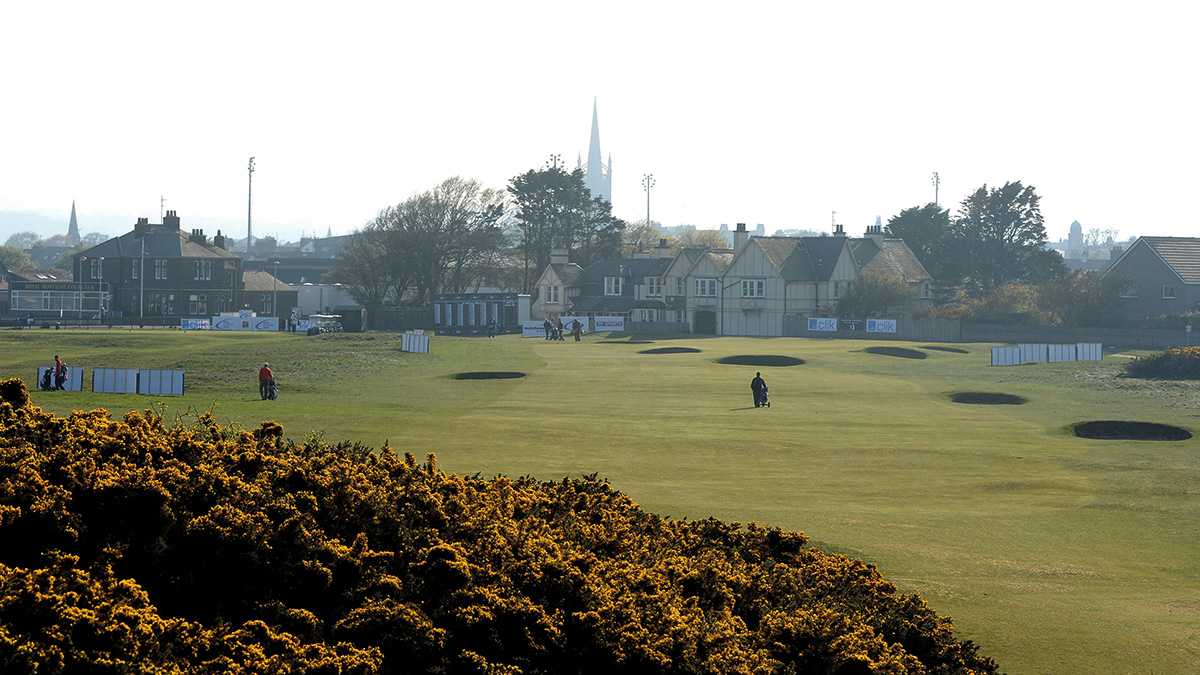- Homepage
- News and Features
- The golf course that's falling into the sea
The golf course that's falling into the sea

Paul Teviotdale
Course Manager, Montrose
Golf has been played at Montrose on the east coast of Scotland since 1562 but, as Course Manager Paul Teviotdale reveals, storms fuelled by the changing climate are taking away the historic Angus layout at an increasing rate.
When the winds howl and the rains lash the Angus coastline, all Paul Teviotdale can do is cross his fingers and hope.
Then the walk begins. Up to the back of the 1st green to see how much more of his golf course has disappeared into the sands.
Montrose’s course manager has arrived at the beach before to find metres of beautifully manicured turf wrenched away and scattered across the rocks.
Golf has been played at this historic layout for nearly 500 years. It’s the fifth oldest course in the world. But it’s falling into the sea at a rapid rate.
“We had to put rock armour around the 2nd tee,” Teviotdale said. “Now the sea is coming over the top of that and it’s starting to take away the sand dune. We can actually just step off the tee and we’d fall onto the beach.


“On the 3rd hole, we built a new tee in 2016 and that’s now on the edge of the dunes. Further up the coast near the 6th tee, we’ve got a tractor path that’s now on the edge. We lost a tee on the other side of that dune which disappeared last winter. That was a replacement tee as well.”
It has been blink and it’s gone for decades. The waters have surged inland up to 80 metres since the 1980s. But the erosion now seems to be accelerating at a much quicker pace.
In 2021, Dynamic Coast predicted Montrose would lose 120 metres of coastline over the next 40 years – roughly working out at three metres every 12 months.
But that much came off the beach thanks to Storms Babet and Gerritt, which crashed through in October and December respectively. More was moved as the waves surged again in February. When it was all added up, seven metres had gone from the coastline in a single year.
Nowhere has the carnage been seen more chillingly than on the 2nd hole. It’s a par 4 that thrills everyone who plays it – but it could soon be gone for good. The dagger-shaped split that’s carved into the fairway is stabbing its way ever further through the heart of the hole.
“It’s coming,” Teviotdale said. “We were trying to figure out plans at the start of this year: What we would do if Point A was breached, Point B and Point C? We do have a plan to move the 2nd hole completely. We’d have to redo the 1st green because the back of it is maybe six yards from the end of the dunes just now.
“It’s not out of the question that we might have to move the 1st green as well in the next year or two. The plan is potentially to move the 2nd hole and go through the dunes and down onto the 17th fairway. We’d use the 2nd fairway on the Broomfield [course] to come back to the 17th green. You do that, but how much longer do you have? It would probably see my time out but it’s whether the guys who would take over from me would have to do something again in 20, 30 or 40 years’ time.”

The scene after the storms have once more torn away strips can be described by Teviotdale in just one word: “Devastation”.
“You fear coming into work, what you’re actually turning up to,” he said. “Back in February, myself, the pro and the general manager were all on the 2nd tee watching the waves come in and just take chunk after chunk after chunk away. I’m thinking ‘hopefully this stops at some point’.
“We had the Senior Open qualifier a few weeks ago and we were fearing we might not have a 2nd tee. Then we’d have to build something and then The R&A would potentially look at the course and think, ‘it’s not really long enough now’. We’d have been looking at losing 70 yards off that hole if we’d had to move the tee.”
Can anything be done to stem the tides? A recent Guardian report said studies by Angus Council and Dynamic Coast revealed urgent maintenance was needed at Montrose Bay and EnviroCentre said work on the beach might cost £2 million.
In January, the Scottish Government announced the council would be given £440,000 to combat the erosion. The same Guardian report reveals hopes that large amounts of sand can reinforce the most-at-risk areas next year. Paul isn’t sure how far those funds would go to solving the problem. He’s also concerned that a much bigger threat lies ahead.
“I think the local council and the government have been thinking ‘it’s not a big issue. It’s not going to happen when I’m in charge’ and the problem’s been put further and further back to the next person or the person after that. Now, it’s a case of ‘we’re in trouble here’. It’s not just the golf course that’s potentially in danger. It’s the town. We’ve maybe 50 or 60 yards and if that dune line goes, you’re almost at town level.
“I’m hoping the council now realise there is maybe a wee bit more of an issue than they actually thought, and it’s coming a lot quicker now. They’ve been spending a lot of money down the sea front and that was badly affected during the winter as well. You’re hoping they see what the golf course brings in to the local community – golfers staying in hotels and going out to pubs and restaurants – and they can see the golf club isn’t just for locals. There are a lot of visitors who come and play and [it’s] the money they could be losing there.”
Without outside assistance, Paul reckons there is nothing he and his team can do. Mowers and spades won’t hold back the storms.
“We are completely at the mercy. We’ve got nothing we can do. Absolutely nothing. It’s not as if we can go down on the beach and start putting stuff on it or try and change the way we do things. The sea is just going to come and take it.”
What if it happens again? What if another seven metres disappear over the next few months?
“It wouldn’t be far away from our potential site for the new 2nd tee,” Paul said. “The current 2nd tee would definitely be gone if we lose another seven metres. The back of the 1st green would be hanging.”
So now it’s a waiting game. What will Mother Nature do next? It might be demoralising for some. It might bring a feeling of helplessness for others. But Teviotdale and his team at Montrose aren’t to be found drowning their sorrors.
“I’m a kind of happy go-lucky guy,” he said. “I try not to worry about anything at all. What happens will happen. We can’t control this kind of thing. I keep saying to the guys, ‘as long as we’re still here, building tees, building greens, building fairways, we’ve still got jobs’. It’s not going to go away in our time.
“We’ll all be safe for jobs until we retire. If the golf course is here, we’ve got a job. If we’re continually moving stuff, we’ve still got a job. It’s when we can’t move it, that’s when we start worrying.”
This article was first published in Your Course, the twice-yearly publication from the British and International Golf Greenkeepers Association. Your Course invites golfers to gain a deeper appreciation of what preparing and maintaining a golf course really involves. Head to www.bigga.org.uk to find out more.
Author

